
Posts Tagged ‘ontologia’
Language, speaking and native culture
In the work of Heidegger: Hölderlin and the essence of poetry, 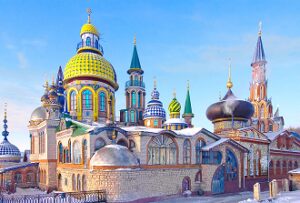 read in Heidegger (1992) speaks of the essence of poetry as a type of primordial language, an original speech that precedes and makes possible the common language, the communication, this refers to an unprecedented fusion of horizons in language and language, classically defines language as: “it is an organized set of elements (sounds and gestures) that enable the communication of a given nation or culture”, while language would encompass a broader set that includes the ability of human beings to develop and understand the language, as if it were possible to dissociate it from contexts, cultures and forms of communication linked to culture.
read in Heidegger (1992) speaks of the essence of poetry as a type of primordial language, an original speech that precedes and makes possible the common language, the communication, this refers to an unprecedented fusion of horizons in language and language, classically defines language as: “it is an organized set of elements (sounds and gestures) that enable the communication of a given nation or culture”, while language would encompass a broader set that includes the ability of human beings to develop and understand the language, as if it were possible to dissociate it from contexts, cultures and forms of communication linked to culture.
The common language in which a certain original culture is communicated, keeps its own forms of a linguistic code that is necessary for each original language and develops in a creative way in order to preserve it, this speech (or word) is said to be that one. who names the gods, and does so to respond to a cultural appeal.
If in the past narratives included myths, symbols and poetic hooks to connect the narrative, today it is no different, there is always in speech some belief and some fantasy, without which poetic language would be a mere exercise in rhetoric, and it is not, and this appeal to fantasy, imagination and the transcendent is part of the human and the divine.
Wanting all speech to be pragmatic and objective is to reduce it to the context of pure formal logic, scientific exercise also often needs some exercise in the beyond, in the imagination to find answers that are not just there as a logical equation.
It is not pure daydreaming, beliefs and imaginaries have always been part of human history, it is a just desire to go further, to seek higher flights and to imagine as possible something beyond the boring and heavy day to day, even though it may contain joys. and flavors, the threshold of openness to different original cultures cannot be linked only to objective and simple realism.
In the photo above, a syncretic church built in Kazan, started in 1992, therefore, in the post-Soviet period, capital of Tatarstan (Russian Republic, but with a totally different culture) where, even with the predominance of Islam followed by the Orthodox Church, it is at the same time a symbol of resistance to the Russian linguistic complex and capable of building a work of such great significance where different religions can express themselves, an eclectic work by the architect Ildar Khanov.
HEIDEGGER, M. (1992) Arte y poesía. Argentina, Buenos Aires: Fondo de Cultura Económica.
Truth and language
Is it possible to really speak? or to ask a more contemporary question, is it possible to deny the truth without falling into relativism? Only the logical truth that comes from Parmenides “being is and non-being is not”, was expressed until very recently as the only truth, but it is the foundation of positivism and dualistic logic, the idea of considering historicity and the hermeneutic circularity places subject and object within a relationship with language.
question, is it possible to deny the truth without falling into relativism? Only the logical truth that comes from Parmenides “being is and non-being is not”, was expressed until very recently as the only truth, but it is the foundation of positivism and dualistic logic, the idea of considering historicity and the hermeneutic circularity places subject and object within a relationship with language.
In this scope of the language of language, truth is re-signified, no longer conceived as unique, as a faithful description, and starting to be seen as a partial, creative but limited redescription of things, as a possible interpretation in a given context and cultural situation determination. , for this it is necessary to understand language as something prior to everyday language, what Heidegger called attention to in Hölderlin’s poetics as the essence of poetry as a type of primordial language, an originary speech that precedes and makes possible the common language, the Communication.
How then is it possible to speak of the truth? It is only possible to speak of the truth taking into account the historicity and hermeneutic circularity of subject and object, which are within the scope of language. Thus, the truth is re-signified, no longer conceived as unique, as a faithful description, starting to be seen as a partial, creative and limited redescription of things, as an interpretation among other possible ones. One possibility of speaking in truth is through language. But for that, it is necessary to resort to an understanding of language that is prior to the language of everyday life, of communication. In Hölderlin and the Essence of Poetry, Heidegger (1992, p. 125-148) speaks of the essence of poetry as a type of primordial language, an originary speech that precedes and makes possible the common language, the communication;
Since language is the mediation of our relationship with being, it is what establishes this relationship, more clearly what is said in Heidegger: “where does man assume the requirement to enter the essence of something? Man can only assume this demand from where he receives it. It receives it in the appeal of language … it is language that, first and ultimately, beckons us to the essence of something” (HEIDEGGER, 2002, P. 167-168).
Thus, the truth must be understood in the context of the linguistic turn (or reversal), the contemporary rediscovery of the importance of language and it cannot be separated from the original historicity, the one that refers to the culture of the peoples and religions of the past and the present.
HEIDEGGER, M. (2002). Ensaios e leituras (Essays and lectures). Brazil, Petrópolis: ed. Vozes.
The truth among men
Gadamer establishes the need for co-reference for the construction 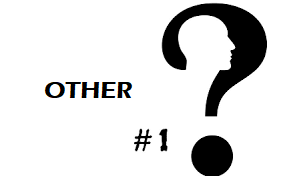 of truth among men, the philosopher Socrates also said that the truth is not with men, but among men, so every self-referential discourse, even that appropriated by a group no longer has a truth growing and becomes just rhetoric.
of truth among men, the philosopher Socrates also said that the truth is not with men, but among men, so every self-referential discourse, even that appropriated by a group no longer has a truth growing and becomes just rhetoric.
Emmanuel Lévinas (1906-1995) developed the aspect of human finitude, as that which gives a provisional totality, in his book Totalidade e Infinito where he discusses the theme of alterity, with a central issue that is not being able to objectify the Other , and it is not about subjectivity, but the possibility of thinking of the Other in its absolute Otherness, in other words, as a totally other.
His book cannot be understood without an analysis focused on Husserl and Heidegger because of its phenomenological option in which it is affiliated, thus developing in this first chapter the category of alternation, while the second will deal with interiority, there appear notions of categories such as: jouissance , economy, home, ownership, work and the feminine is a topic that is so current in the question of gender and reflects the relationship of the Self with the real, enabling the building of a being at the same time separate and open to the outside.
Thus, the third chapter relates to the exteriority that underlies an ethics proposed by Lévinas, how an opening is given or built in Being, through the analysis of the categories of Infinity, Face and Exteriority, they are fundamental for the understanding of the Levinasian universe. .
The problem of human finitude in the aspect of truth can refer to a transcendence different from the idealist proposal, where the imperative category is linked to the concept of subjectivity: “acts in such a way that it is a model for others”, thus it is possible to develop in a personal universe an ethics, while for Lévinas, as it is for Gadamer and it was for Socrates, truth can only exist in a process of dialog with the Other and with the outside, every closure is self-referential.
Thus the “Other remains infinitely transcendent, infinitely strange, but his face, where his epiphany takes place and which appeals to me, breaks with the world that may be common to us and whose potentialities are inscribed in our nature and which we also develop in our existence” (Lévinas, 2008), here an epiphany that is only human.
We approach the Christmas feasts, in the Christian liturgy it is the feast of the divine epiphany, the divine manifestation to the peoples, for many only the feast of the wise men or the baptism of Jesus, but for those who think that the truth is “among men”, the presence of God with Us (Emmanuel) happens from the birth of the God-child.
In the biblical text (Jn 18: 37), when asked by Pilate if Jesus was the king of the Jews, he replied: “You say: I am king. I was born and came into the world for this: to bear witness to the truth. Everyone who is of the truth listens to my voice”, thus this truth among men is also established for Christian culture as the incarnate word.
Truth and finities´s humans
Not only did Hans Georg Gadamer write about the truth regarding Human finitude, Emmanuel Lévinas also developed the theme.
Human finitude, Emmanuel Lévinas also developed the theme.
In Gadamer, the conclusion about the truth of human experience is the awareness of its finitude, that is, it is knowing your own limits, knowing that you are not lord of time and the future, nowadays that you are not lord of nature and its behavior , the great Enlightenment ideal, and so it has its limits and its plans are insecure.
Thus, in Gadamer, the issue of rhetoric and discourse is not exactly an issue and the question is not really called into question, to be able to question it is necessary to really want to know the truth and it may be outside the limits of the questioner, says in your text:
“To ask, you have to want to know, that is, to know that you don’t know. And in the exchange of questions and answers, of knowing and not knowing, described by Plato as a comedy, one ends up recognizing that for all knowledge and discourse in which one wants to know the content of things, the question takes precedence. A conversation that wants to explain something needs to break these things through with a question” (GADAMER, 2008, p. 474).
Thus, it will be inscribed beyond prejudice, and in the constitution of new horizons, thus understanding the text or a fragment of the past, for Gadamer is to understand it from the issue that should be seen as a process of continuous fusion or broadening of horizons through which the interpreter participates with others in the long and arduous path of meaning, he goes beyond the romantic and historical Enlightenment point of view, which is unacceptable: the symbolic and plural language, characteristic of the narrativity of things.
But what does this mean? what this means for the philosophical hermeneutics that recognizes human finitude, there is no immediate possibility of a coincidence with the real, as every human understanding is linguistically mediated as every language is, in the Aristotelian view, a hermenia (interpreter) originating from the real and this it can be extended to cultures, to peoples, and especially to native peoples, primary sources of discourse and their own language.
As man is finite, only in language can his fundamental dialogical power reach what Western philosophy calls objectivity (proper ideality), but it must go beyond the point of view of the anonymous transcendental subject (idealist subjectivity) to reach the dimension of co. -reference of concrete men, of others.
Concreteness is thus the word that decenters and challenges, places what is said in otherness, and its perspective of tracing a fusion of new horizons does not end.
GADAMER, H.G. Truth and Method I. Fundamental features of a philosophical hermeneutics. 10th ed. Petrópolis, Brazil: Vozes, 2008
Act, potency and agape
What Aristotle defined as potency was conditioned to the act, so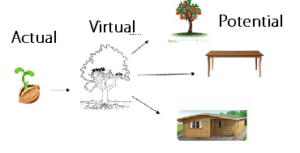 the act is a current manifestation, in the example of the figure beside the seed), while potency is what could be (virtually, while virtú) the seed in potency is a tree could its manifestation as being to produce fruits and new seeds, while virtual, in the sense of virtue, is to transform it into a table or even a house.
the act is a current manifestation, in the example of the figure beside the seed), while potency is what could be (virtually, while virtú) the seed in potency is a tree could its manifestation as being to produce fruits and new seeds, while virtual, in the sense of virtue, is to transform it into a table or even a house.
Actual potential actualization is not just the seed that becomes a tree and bears fruit, the main source of change must be completely real and not only correspond to natural potentiality, but that which completes the rest, and this depended on Aristotle’s The first motor that gave meaning to everything, and that Thomas and Aquinas claims to be God, enters the question of conscience.
Here comes Logos or Pathos, since consciousness is always a dictate of reason and will, so for Thomas Aquinas Ethos depends essentially on human will and consciousness, while Logos leads us to a more primordial reason for Being , Pathos moves towards disordered passions and drives, while Logos should lead us to agape and balance.
Potency is thus characteristic of Being and Pathos its distortion, power seen as Pathos is authoritarian and passionate, while power as Ethos is ethical and agapic, in the sense of service done out of gratuitous love to those they are subordinate, so it can until there is asymmetry, but it will only be diversity and never authority in the sense of absolute power as it is united with the Logos.
It is not by chance that Aristotle was tutor of Alexander the Great, and his form of power spread to the peoples, as well as Plutarch in his text “Alexandre (in Parallel Lives”, 1st century): “After this battle of Issus… Macedonians form to take a liking to the other, silver and women, and the way of life of the Asians, becoming so fond of it that, as if dogs, they set out on the trail in search and pursuit of the opulence of the Persians”, is likely. which also influenced the Romans.
That’s how we reach the second war and the dangers of post-modernity, will we leave our childhood civilization and will one day be able to coexist with peoples with different cultures and cosmogonies, we seem to be heading in the opposite direction: polarization.
It was also no different for Jews and Christians, in the nascent community many wanted to have “power” alongside Jesus, in the reading of Mark (Mk 10:36-37) the apostles James and John make a special request to Jesus: “He he asked, ‘What do you want me to do for you?’ They replied, ‘Let us sit one on your right and one on your left, when you are in your glory,’ and the master tells them they don’t know what they’re asking for.
Ai asks if they can drink from the cup that He will drink (referring to their type of death), they keep saying yes, then rebuke them and tell the form of power that exists in civilization (Mark 10: 42-43): “Jesus called them and said: ‘You know that the heads of the nations oppress them and the great ones tyrannize them. But among you, it must not be like that: whoever wants to be great, be your service and whoever wants to be first, be the slave of all”.
So those who govern believers in the same way as the temporal power have not yet understood the potency of the agapic Logos.
Crisis of thought and cynical reason
Modern thought is still strongly linked to idealism, there are several points to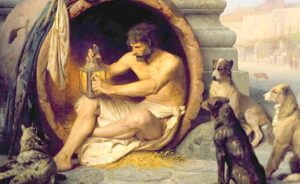 question Kant’s Critique of Pure Reason, two points that I consider central: the subject and object dualism (called the infernal dichotomy by Bruno Latour) and the transformation of eidos Greek in an abstract idea, almost all contemporary Western philosophy is heir to Kant.
question Kant’s Critique of Pure Reason, two points that I consider central: the subject and object dualism (called the infernal dichotomy by Bruno Latour) and the transformation of eidos Greek in an abstract idea, almost all contemporary Western philosophy is heir to Kant.
The crisis of Greek “democracy” (questionable because slaves and women did not participate) happened amidst the crisis of sophistic thinking, founded on relativism and the justification of power, the art of rhetoric and oratory and the power of argumentation was worth more than the truth.
There, too, another infernal dichotomy is born: between nature (phýsis) and culture (nómos), after all, what is nature and what we mean by culture when we distance it from experience and techné.
Sloteridjk is one of the rare Western philosophers who will question without losing the rationalist and progressive slant, both the classic current models of argumentation and Adorno and Horkheimer, Sartre and Foucault, neither escapes nor Heidegger, who in a way is also heir, by questioning his Charter on Humanism, and thinking about what humanism actually is today.
What you call culture, for example, can show the contradiction, giving the example of China where you can eat dog meat and in India you can’t eat beef, which is a sacred animal.
The point that I consider most central is the explanation of modern relativism, since this was also the foundation of the Greek sophists, there everything that referred to practical life could be changed, so both religion and politics were considered cultural factors and could be modified is convergent, according to Sloterdijk with modern thought, according to his analysis of the concepts of cynicism and kynisms, its founder Antisthenes of Athens (445-365 BC) preached a simple life as a wild life (in nature, the word kynós means dog), the figure of Diogenes in his barrel is the most emblematic (in the painting above, Jean Leon Gerome).
Although a disciple of Socrates, unlike Plato, he opted only for the stereotype of the master, as opposed to educating and organizing an “episteme”, he will make everything simple and relative.
The context of these sophists was the city-state and the democracy of Athens which was in crisis.
The second part of Sloterdijk’s book is a critique of applied cynicism, structured in four parts: physiognomic, phenomenological, logical and historical.
Sloterdijk, P. Critique of Cynic Reason, trans. Marco Casanova et al., Brazil, SP: Estação Liberdade, 2012.
The agnostic version of heaven’s bread
Ignoring poetic language is not just ignoring metaphor, analogies do have a metaphysical limitation, but metaphor goes beyond analogy and there are assumptions in it that have yet to be verified by science as truth.
do have a metaphysical limitation, but metaphor goes beyond analogy and there are assumptions in it that have yet to be verified by science as truth.
Paul Ricoeur clarifies: “what remains remarkable for us who come after the Kantian critique of this type of ontology is the way in which the thinker behaves in relation to the difficulties internal to his own solution…. of the categorical problem is resumed in its broad lines” (Ricoeur, 2005, p. 419).
This is not only linked to the idea of the analogy that was re-elaborated by Thomism, but the main source of all the difficulties “is due to the need to support the analogical predication by an ontology of participation” (p. 420), this analogy is in the level of names and predicates, thus “it is of the conceptual order” (p. 421).
The attack on metaphor and metaphysics reached modernity, he stated “Thought looks listening and listens while looking” (Heidegger apud Ricoeur, 2005, p. 436), and Jean Greisch says that this “leap” places language in “the ´there is´ es gibt [has], there is no possible transition” and this would be the deviation.
Ricoeur himself replies that what makes this enunciation as a metaphor is the harmony (einklang) between ist and Grund in the “nothing is without reason”, it is necessary to understand the metaphor-statement.
Remember the biblical passage about Pharisaism unable to understand the divine transcendence (Jn 6:42), “Is not this Jesus the son of Joseph? Don’t we know your father and mother? How then can you say that you came down from heaven?”, and that is why they cannot understand the bread of heaven, the divine food, because they are trapped in material food alone.
There is indeed a metaphor-statement that links material food to divine food, but harmony is not being tied to one by submitting it to another, as explained in the previous post, this was the great Thomist argument to overcome the Aristotelian analogy: science divine is to God, what human science is to the created” (Ricoeur, 2005, p. 423), quoting Aquino’s De Veritate.
Of course, the problem of metaphor and poetics is not limited to divine knowledge, but it does not prevent it.
From metaphysics to ontology
There is no dishonorable resource of using metaphor to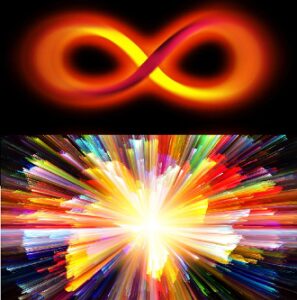 affirm metaphysics, as Ricoeur asked, the Thomist resource “did not stop at the solution closest to the Platonic exemplary adopted in the commentary on Book I of the Sentences, still under the influence of Alberto the Great” (Ricoeur, 2005, p . 421).
affirm metaphysics, as Ricoeur asked, the Thomist resource “did not stop at the solution closest to the Platonic exemplary adopted in the commentary on Book I of the Sentences, still under the influence of Alberto the Great” (Ricoeur, 2005, p . 421).
Aquinas, when working on being, potency and act (his great categories), conceives an order of descent “in the series being, substance and accident” observes Ricoeur, “according to which one receives the other esse et rationem”, and thus establishes another analogy as described in Distintio XXXV (q. 1, ar. 4):
“There is another analogy [besides the order of priority] when a term imitates another as much as it can, but does not match it perfectly, and this analogy is found between God and creatures” (Aquino apud Ricoeur, 2005, p. 421), and explains Ricoeur it is necessary to understand this feature of a common term between God and creatures, and this can be explained thus:
“Between God and creatures there is no similarity through something common, but through imitation, from which it is said that the creature is similar to God, but not the other way around, as Pseudo-Dionysius says” (idem).
This participation by similarity means that “it is God himself who communicates his likeness: the diminished image ensures an imperfect and inadequate representation of the divine exemplar” (Ricoeur, 2005, p. 422), and this has a weakness: “the total disjunction between attribution of names and categorical attribution” (idem), thus the theological discourse “loses all support in the categorical discourse of being”.
The resource already pointed out above being as an act and power, direct similarity is still close to univocity, so Aquino observes that exemplary causality, due to its formal character, must be subordinated to efficient causality, the only one that founds the communication of underlying being analog assignment. The discovery of being as an act then becomes the ontological foundation of the theory of analogy” (RICOEUR, 2005, p. 422).
The discourse is too philosophical, and I simplify it here: God is pure being in act and potency, the creature is being in act and can be in potency, so Thomas Aquinas develops this.
Aquinate in De Veritate distinguishes two types of analogy, one proportional (proportio), for example a number and its double, and another one of proportional relation (proportionalitas) which is a similarity of relation, in numbers, for example, 6 is to 3 as 4 is to 2.
Of course this is not just mathematics, Ricoeur does this as a didactic resource, the infinite and the finite are disproportionate, but it can be said (divine science is for God, what human science is for the created” (Ricoeur, 2005, p. 423) and which is a quotation from Thomas Aquinas’ De veritate.
Ricoeur, P. (2005) Metáfora viva. trad. Dion David Macedo. BR, São Paulo: Edições Loyola.
Metaphor and Metaphysics
The peak and decline of Aristotle’s metaphysics, in Paul Ricoeur’s 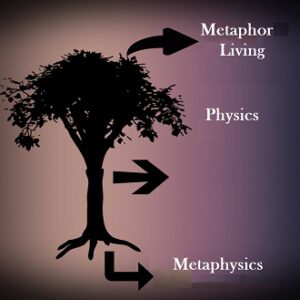 analysis, is “in the non-scientific characteristics of analogy, taken without its terminal meaning, regroup in his eyes in an argument against analogy” (Ricoeur, 2005, p. 414), and as the analogy was linked to the question of being, ontological questions are submerged with it.
analysis, is “in the non-scientific characteristics of analogy, taken without its terminal meaning, regroup in his eyes in an argument against analogy” (Ricoeur, 2005, p. 414), and as the analogy was linked to the question of being, ontological questions are submerged with it.
However, Ricoeur clarifies, “it is because the ‘investigation’ of a non-generic connection of being remains a task for thought, even after the failure of Aristotle, that the problem of the ‘conducting thread’ will continue to be presented even in modern philosophy. ” (RICOEUR, 2005, p. 415).
For the author, while “the first gesture continues to be the conquest of a difference between transcendental analogy and poetic similarity” (Ricoeur, 2005, p. 416), which he explains and will not be extended here, the second “counter- example” of the “discontinuity of speculative discourse and poetic discourse” is much more serious, and it ranges from Kant’s discourse to Heidegger.
He explains that this was done in a mixed discourse that the doctrine of analogy entis reached in its full development and that was called ontotheology, due to the pretension of linking divine transcendence to Being, but ignoring the Thomistic discourse, which is “an inestimable testimony”.
What Aquinas does is “establish theological discourse at the level of a science and thus completely subtract it from the poetic forms of religious discourse, even at the price of a rupture between the science of God and biblical hermeneutics” (p. 417) .
However, the problem is more complex “than that of the regulated diversity of the categories of being of Aristotle”, “to speak rationally of the creator God of the Judeo-Christian tradition. The bet is to be able to extend to the question of divine names the problematic of the analogy raised by the equivocal notion of being” (p. 417), remember here the battle between nominalists and medieval realists.
Explaining that the doctrine of the analogy of being was born “from this ambition to involve in a single doctrine the horizontal relation of categories to substance and the vertical relation of created things to the creator” (p. 419), now this was exactly the project of an ontotheology .
Thus, the Thomistic discourse “rediscovers a similar alternative: to invoke a discourse common to God and creatures would be to ruin divine transcendence, to assume a total incommunicability of the meanings from one plane to the other would be, in compensation, to condemn oneself to the most complete agnosticism” (p. 418), he takes up the categorical problem “in its broad lines” and “it is the very concept of analogy that must be constantly re-elaborated” (p. 420).
A question remains to be answered, wouldn’t this be a “return from metaphysics to poetry, through a dishonorable recourse to metaphor, according to the argument that Aristotle opposed to Platonism?” (p. 421).
Metaphor and speculation
There is nothing in philosophical discourse (or in well-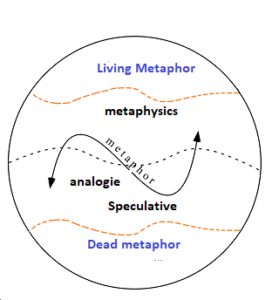 structured thinking) that is free from presuppositions.
structured thinking) that is free from presuppositions.
In the living metaphor, Paul Ricoeur clarifies that this is “for the simple reason that the work of thought by which a region of the thinkable is thematized brings into play operational concepts that cannot, at the same time, be thematized” (Ricoeur, 2005, p. 391).
These postulates are fundamental to understanding discourse, rhetoric and mere speculation.
Paul Ricoeur makes this study around the questions: “Which philosophy is involved in the movement that leads the investigation from rhetoric to semantics and from meaning to reference? “(idem).
It will be in the answer to these questions, and “without reaching the conception suggested by Wittgenstein of a radical heterogeneity of language games” (Ricoeur, 2005, p. 392) it is possible to recognize: “in its principle, the discontinuity that ensures the speculative discourse its autonomy” (idem).
Not explained by Ricoeur, but Edgar Morin talks about two roots of modern discourse that lead speculative discourse to a modern form of obscurantism: the closure in areas of overly specialized knowledge, which he calls hyperspecialization.
Here, metaphor can be confused with mere speculation and philosophy would be “induced by the metaphorical functioning, if it could show that it only reproduces, on the speculative level, the semantic functioning of poetic discourse” (idem).
He clarifies that the touchstone of this misunderstanding is “the Aristotelian doctrine of the analogical unity of the multiple meanings of being, ancestor of the medieval doctrine of the analogy of being” (idem) which we will return to in the next post to understand the metaphysical limitations of Aristotelian ontology.
The second, more fundamental clarification is the categorical discourse, where “there is no transition between poetic metaphor and transcendental equivocality” which is the conjunction between theology and philosophy “in a mixed discourse” that creates confusion between analogy and metaphor” (Ricoeur , 2005, p. 393), and would this imply “a sub-reption, to return a Kantian expression?” (idem), for this reason it is necessary to return to the metaphysical question and in it the ontological question.
He quotes as an epigraph Heidegger’s statement that “the metaphorical only exists within metaphysics”, this is the heart of this work by Ricoeur, and he calls it a “second navigation”, an allusion to Jacques Derridá’s “Mytologie blanche”, passing from living metaphor to dead metaphor.
Ricoeur, P. (2005) Metáfora viva. trad. Dion David Macedo. Brazil, SP: Ed. Loyola.

